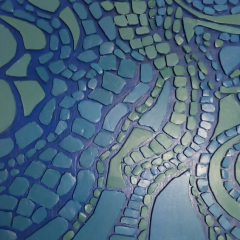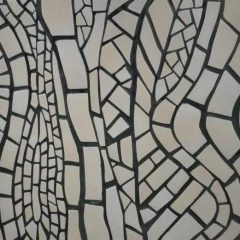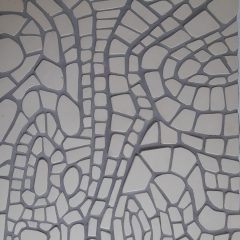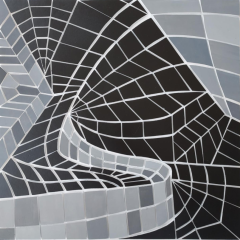General
The object of the course is the systematic approach, design and construction of an artistic proposal (mosaic), with analog or digital tools, on medium or large scale surfaces.
Course content
The object of the course is the systematic approach, design and construction of an artistic proposal, with analog or digital tools, on medium or large scale surfaces. The design theme (exercise) given to the students is differentiated every semester and is developed according to the following methodological approach.
– Research and archiving.
– Study of archival – historical material if any.
– Design illustration of the space, and the application wall at a scale of 1: 100 or 1:50 – Study of lighting.
– Study and recording of the structural features of buildings or surfaces adjacent to the space.
– Organization of the concept or the central idea, based on the findings of the research.
– Digital simulation and representation of the artistic proposal in space.
– Documentation of the design criteria in a short text.
– Creation of a mosaic, per group [2 people], on a medium-sized portable surface.
– The design tools of creation and presentation are the choice of each student.
Knowledge of image editing software is essential. The course includes theory (lectures) regarding the material we are working on. During the semester, visits and on-site studies are made at the application sites. The chronological sequence and topics of the theoretical lectures are summarized in the following table:
– Introduction to the art of mosaic.
– The semiology of mosaics in Islamic culture.
– Mosaics and ceramic tiles in Neo-Gothic architecture.
– Art Nouveau and mosaics: the tiles in the work of Antonin Gaudi.
– Raymonde Isidore: Mosaics for La Maison Picassiette (1938 – 1964).
– Eduardo Paolozzi wall-mounted mosaics / installations at Tottenham Court Underground Station in London (1980-84).
– The revival of the art of mosaics in the Rome metro (1970-1990).
– International Exhibitions of Mosaics in Europe and America (2005-2017).
– The synchronicity in the mosaics of Kaffe Fassett and Candace Bahouth.
– The mosaic as an application in modern design – Materials, stratigraphy in Byzantine and Roman mosaics. – Integration of mosaic in the architectural space.
– Composition design with digital image editing programs [formatting, color relations].
– Applied design criteria, visual communication.
– Criteria for artistic intervention in public spaces.
Programme aims
The course focuses on visual applications, with the technique of mosaic, on small or large scale surfaces. It is placed in a wider framework of applied surface design and aims at:
– in the research and promotion of decoration techniques which stem from our tradition and cultural heritage.
– in their connection with modern design.
– familiarity with the technical and aesthetic requirements of mosaic.
Learning Outcomes: Knowledge and Understanding
The course aims to develop students’ design and synthetic skills, their critical thinking and their awareness of techniques that can be developed into a modern design tool. After the end of the course students will be able to:
– Methodically organize the design process according to the requirements of the art of mosaic, in wall and floor installations.
– Handle the appropriate means and tools for the implementation of the design. – Use their technological knowledge and skills [digital tools] for the creation of complex design proposals.
– Learn the art of mosaic and its applications in modern design.
– Undertake the study and supervision of decoration of medium and large scale surfaces in indoor and outdoor public and private spaces.
– Express themselves creatively with an applied art that can offer them profitable professional prospects.
Bibliography
– Τσούμας Ι., Η Ιστορία των Διακοσμητικών Τεχνών & της Αρχιτεκτονικής στην Ευρώπη & την Αμερική (1760-1914). Εκδόσεις Ίων, Αθήνα 2005
– Φιλιππίδης Δ., Διακοσμητικές τέχνες. Τρεις αιώνες τέχνης στην Ελληνική αρχιτεκτονική. Εκδόσεις Μέλισσα, Αθήνα 1998
– Φραγκόπουλος Μ., Εισαγωγή στην Ιστορία και τη θεωρία του Graphic Design. Μια μικρή ανθολογία. Εκδόσεις Futura, Αθήνα 2006
– Μ. Σαντοριναίος, Σ. Ζώη, Ν. Δημητριάδη, Τ. Διαμαντόπουλος, και Γ. Μπαρδάκος, Από τις σύνθετες τέχνες στα υπερμέσα και τους νέους εικονικούς-δυνητικούς χώρους. Ένα εγχειρίδιο για τον καλλιτέχνη που ασχολείται με την ψηφιακή τέχνη. Αθήνα: Σύνδεσμος Ελληνικών Ακαδημαϊκών Βιβλιοθηκών, 2015 [Online]. Διαθέσιμο στο: https://repository.kallipos.gr/handle/11419/6076
– Bachelard, G. (1969). The poetics of space. Boston: Beacon Press. http://www.teiath.gr/userfiles/eadsa_web_admin/lessons/e_semester/spoudastes/2012-13_PoitikiXorouBachelard.pdf
– Barthes, R. (1970,1984). «Centre-ville, centre vide / Κέντρο πόλη, κέντρο κενό», L’empire des signes / Η επικράτεια των σημείων (1970), μτφρ. Κ. Παπαϊακώβου, Αθήνα: εκδ. Ράππα.
– Μπακιρτζής, Χ., (2012), Ψηφιδωτά της Θεσσαλονίκης. Θες/κη: Εκδόσεις Καπόν.
– Ατζάκα, Γ., (2011), Το επάγγελμα του ψηφοθέτη. Αθήνα: Εκδόσεις Άγρα.
– Ασημακοπούλου, Π., (2003), Ψηφιδωτά δάπεδα. Θες/κη: University Studio Press.
– Χατζηδάκη, Θ., (1994), Βυζαντινά Ψηφιδωτά. Θες/κη: University Studio Press.
– Peck, K., (2003), Plaster Mosaics. Iola: Krause Publications.
– Mastandrea, D., (2001), Mosaics inside and out. Massachussets: Rockport Publications.
– Dunbabin, K., (1999), Mosaics of the Greek and Roman World. Cambridge: Cambridge University Press.
– Ling, R., (1998), Ancient Mosaics. London: British Museum Press.
– Hunkin, T., (2003), Modern Mosaics: Inspiration from the 20th Century. London: Anova Books.
– Kent, C. and Prindle, D., (1993), Park Guell. New Jersey: Princeton Architectural Press.
– Hannam, J., (2011), The Vesuvius Mosaic. Oxford: Oxford University Press.
– Charles, V., (2011), Art Nouveau. New York: Parkstone International Ltd.
– Paolozzi, E., (1984), Private Vision-Public Art. London: Architectural Association.
– Budd, O., (2014), Masters of Mosaics. London: Robert Hale Limited.
– Frith, A., (2004), Pebble Mosaics. Exeter: David & Charles.







